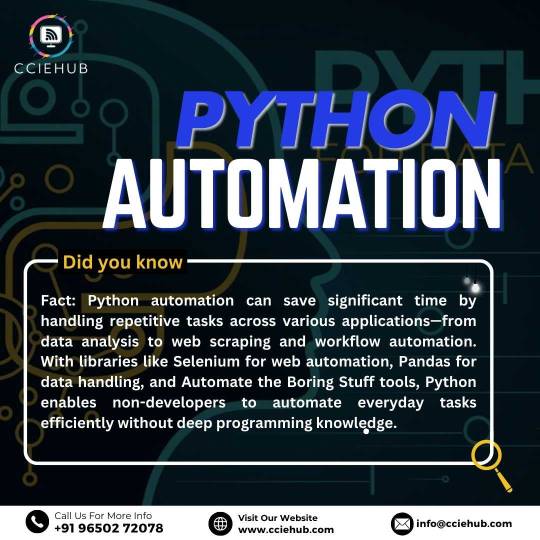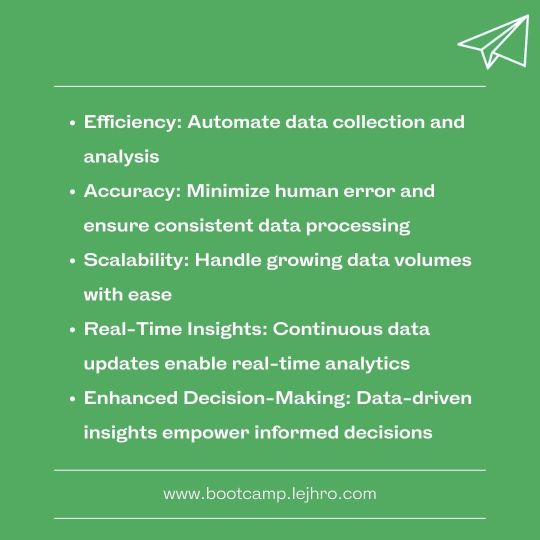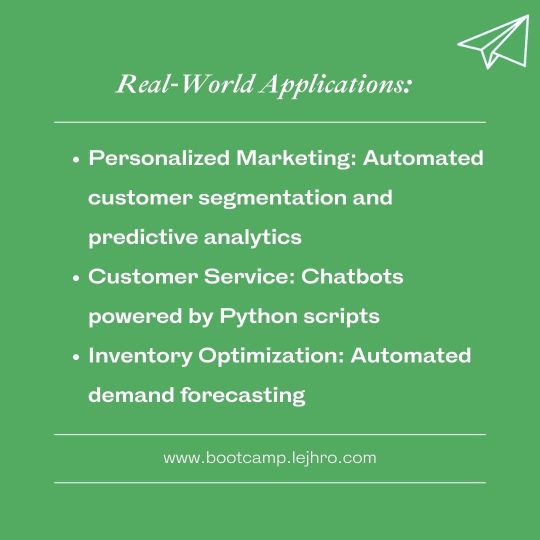#python automation
Explore tagged Tumblr posts
Text

Our *Automation Testing with Python* training in Delhi NCR, India, is designed for professionals seeking to master automation frameworks and streamline software testing processes. Through hands-on sessions, participants will learn Python's powerful libraries like Selenium, PyTest, and Unittest to create robust test scripts. Led by industry experts, this course is ideal for those aiming to boost their skills in test automation and ensure high software quality. Gain in-demand expertise and advance your testing career with us!
1 note
·
View note
Text
#Python programming#Python for beginners#Python development#Web development with Python#Python training course#Python automation
0 notes
Text
Python for Automation: Supercharge Your Productivity
In the digital age, efficiency is the new currency. Businesses are constantly on the lookout for ways to streamline operations and boost productivity. One of the most effective ways to achieve this is through automation. And when it comes to automation, Python is the go-to language for many developers and businesses.

Why Python for Automation?
Python is a high-level, interpreted programming language known for its simplicity and readability. Its syntax is clean and easy to understand, which makes it a great choice for beginners. But don’t let its simplicity fool you. Python is a powerful language that can handle a wide range of tasks, from data analysis to web development and, of course, automation.
Python’s extensive library support is another reason why it’s a popular choice for automation. Libraries like Selenium for web automation, Pandas for data manipulation, or even built-in libraries like os and sys for system-level tasks, make Python a versatile tool for automation.
Supercharging Your Productivity with Python
Automation can significantly boost your productivity by taking over repetitive tasks. For instance, Python can automate mundane tasks like reading and writing files, scraping data from websites, sending emails, and more. This allows you to focus on more complex tasks that require human intelligence.
Imagine having a Python script that automatically sorts and organizes your files, or a script that scrapes data from a website every day and sends you an email with a summary. These are just a few examples of how Python can supercharge your productivity.
Hiring a Python Developer
If you’re not familiar with Python or coding in general, don’t worry. You can always hire Python developer to help you with your automation needs. A skilled Python developer can help you identify tasks that can be automated, write efficient scripts, and even train you to maintain and update the scripts as needed.
When hiring a Python developer, look for someone with experience in automation and the libraries you need. They should also have good problem-solving skills and a deep understanding of Python and its nuances.
Working with a Python Development Company
If your automation needs are extensive, you might want to consider working with a Python development company. These companies have teams of experienced Python developers who can handle large projects. They can provide a range of services, from writing simple automation scripts to developing complex automation systems.
Working with a Python development company also has other benefits. For instance, they can provide ongoing support and maintenance, and they can scale up quickly if needed. Plus, they are more likely to be familiar with the latest Python trends and technologies, which can give you an edge over your competitors.
Conclusion
In conclusion, Python is a powerful tool for automation that can significantly boost your productivity. Whether you’re a solo entrepreneur looking to automate simple tasks, or a large company looking to streamline operations, Python can help. So why wait? Hire a Python developer or partner with a Python development company today, and supercharge your productivity with Python automation.
Q1: What is Python for Automation, and how can it supercharge productivity?
A1: Python for Automation refers to leveraging the Python programming language to automate repetitive tasks and streamline processes. By using Python scripts and tools, individuals can save time, reduce manual effort, and enhance overall productivity in various domains.
Q2: How can Python be used for automation in different industries?
A2: Python's versatility makes it suitable for automation across various industries, including software development, data analysis, system administration, finance, and more. It can automate tasks such as file manipulation, data extraction, web scraping, and routine maintenance, making it a valuable tool in diverse fields.
Q3: What are some key benefits of using Python for automation?
A3: Python offers several advantages for automation, such as simplicity, readability, a vast collection of libraries, and cross-platform compatibility. Its ease of learning and widespread adoption in the tech community contribute to its effectiveness in boosting productivity.
Q4: Are there any prerequisites for learning Python for automation?
A4: While no specific prerequisites are mandatory, having a basic understanding of Python programming fundamentals can be helpful. Familiarity with concepts like variables, loops, and functions will expedite the learning process for automation tasks.
Q5: Can Python be used for both simple and complex automation tasks?
A5: Yes, Python is well-suited for a wide range of automation tasks, from simple repetitive actions to complex workflows. Its simplicity makes it accessible for beginners, while its power and extensibility allow experienced developers to tackle intricate automation challenges.
Q6: What are some real-world examples of Python automation projects?
A6: Examples include automating data extraction and analysis, web scraping, automating routine system administration tasks, creating chatbots, and building scripts for automating software testing. Python's versatility enables it to address diverse automation needs across industries.
Q7: Are there specific libraries or frameworks recommended for Python automation?
A7: Yes, there are several popular libraries and frameworks for Python automation, such as Selenium for web automation, Beautiful Soup for web scraping, Requests for HTTP requests, and PyAutoGUI for GUI automation. The choice depends on the specific requirements of the automation task.
Q8: How can Python for automation enhance collaboration in a team environment?
A8: Python's clear syntax and readability contribute to effective collaboration within teams. By using standardized Python scripts, team members can easily understand and contribute to automation projects. This fosters a collaborative environment and ensures seamless integration of automated processes into workflows.
Q9: Can Python for automation be applied in non-programming fields?
A9: Absolutely. Python's user-friendly syntax and extensive libraries make it accessible to individuals in non-programming fields. It can be applied in areas like data analysis, finance, and research, allowing professionals with diverse backgrounds to leverage automation for increased efficiency.
Q10: Where can one find resources to learn Python for automation?
A10: Numerous online platforms, tutorials, and courses are available for learning Python for automation. Websites like Codecademy, Udemy, and official Python documentation provide comprehensive resources. Additionally, community forums and books dedicated to Python automation are valuable learning assets.
1 note
·
View note
Text
How to Schedule Events in Python | Python Bot
Please Subscribe our YouTube channel Computer Coding Class.
https://www.youtube.com/@computercodingclass
youtube
View On WordPress
1 note
·
View note
Text
i need dan and phil to learn the full story behind their rpftourney win i NEED them to understand how hard we fought in the semifinals i neeeeeeed them to understand how serious tumblr voter fraud is
#dnp#dan and phil#phan#someone needs to tell them that i learned selenium to try to help#and it didn't work bc it turns out the tumblr signup page CAN detect some bots but like the thought was there#then someone explain to them that selenium is a python library for automating inputs to web browsers#uhhh and then probably that python is a programming language? just in case#lou is loud
55 notes
·
View notes
Text
he literally just said on a rally (why is he even doing them still wtf) that he wants to bring the economy back to 1929 we're all so fucking screwed.... we're so fucking screwed
the social stuff can be mitigated... this can't, we're so screwed globally :|
#personal#i guess im not even thinking about job hopping for higher pay this year anymore lol#i'll eat other people's jobs with my automation scripts so that i'm not the layoff#i'm already getting added to the job eater team once im back from vacation.... cause i know some python and the job eating#software uses python for api data requests#like i'm the artist they chose to put on the /automation job eating/ team lol#like im literally the ONLY artist not in a true managerial role put on this team cause i can code a little...and translate to cs nerd#(and all the scripts that i've made at work are just adaptations of my gif automation process... so if#weird boyband special interest mixed with hypernumeracy type autism saves me and my husband from this stupidity#i'll be annoyed but grateful)
3 notes
·
View notes
Text
in so deep into modding sims 3 that I made a script to mass change 2000 cc files' hex header 😭😭😭😭😭
#took me like an hour to two to figure out how to bulk replace code within an application using python script#then i got confused n then just went back to automating keypresses n making a script for that instead 😭😭😭#i was headscratching earlier today bc i couldnt open ny sims 3 cc files within s3pe#turns out there's a version mismatch on the cc file bc i used a sims 4 application to merge and unmerge my cc and that changed the#hex header or whatever from version 2.0 to 2.1 n opening any sims 3 cc file into any s3 software freaked it out bc it couldn't#read 2.1 headers bcoz thats for sims 4#wh#figured that issue out from browsing deep into the sims modding forums after reading the error logs i had (idk why i didnt do that earlier)#n then everything just clicked idk#doing all dat at 5am . man.#doing all this so i dont have to find and redownload 2k cc files 💪💪was fun i learned something#nerd 🤣🫵#going to bed noew dawg!!!!#i have not touched python in 10(?) years i am so cooked#i don't remember shite .#.ctxt
3 notes
·
View notes
Text
Some programs I have created and use.
File Scanner
This program is more of a scanner to search a server and find all the older files. I set it up to scan for older files that are over 7 years old and compile them into an excel file so they can be reviewed before deletion. This is a good program for users for file retention policies. Also to find those information hoarders.
Now the program will ask you for a file path, then ask where you want to store the excel folder.
import os import datetime from openpyxl import Workbook from tkinter import filedialog import tkinter as tk
def get_file_creation_time(file_path): """ Get the creation time of a file. """ print("File path:", file_path) #Debug Print try: return datetime.datetime.fromtimestamp(os.path.getctime(file_path)) except OSError as e: print("Error:", e) #debug print return None
def get_file_size(file_path): """ Get the size of a file. """ return os.path.getsize(file_path)
def list_old_files(folder_path, output_directory): """ List files older than 7 years in a folder and store their information in an Excel file. """ # Initialize Excel workbook wb = Workbook() ws = wb.active ws.append(["File Name", "File Path", "Creation Date", "Size (bytes)"])
# Get current date current_date = datetime.datetime.now()
# Traverse through files in the folder for root, dirs, files in os.walk(folder_path): for file in files: file_path = os.path.join(root, file) creation_time = get_file_creation_time(file_path) if creation_time is None: continue #Skip files that could not be retrived
file_age = current_date - creation_time if file_age.days > 7 * 365: # Check if file is older than 7 years file_size = get_file_size(file_path) ws.append([file, file_path, creation_time.strftime('%Y-%m-%d %H:%M:%S'), file_size])
# Save Excel file to the specified directory output_excel = os.path.join(output_directory, "old_files.xlsx") wb.save(output_excel) print("Old files listed and saved to", output_excel)
if __name__ == "__main__": # Initialize Tkinter root = tk.Tk() root.withdraw() # Hide the main window
# Ask for folder path folder_path = filedialog.askdirectory(title="Select Folder")
# Ask for output directory output_directory = filedialog.askdirectory(title="Select Output Directory")
list_old_files(folder_path, output_directory)
------------------------------------------------------------------------------
Older file Scanner and Delete
Working in the IT field, you will find that the users will fill up the space on the servers with older files.
Especially if you work within an industry that needs to have document retention policies where you can not keep some documents longer than a certain amount of time or you just have hoarders on your network. You will know those people who do not delete anything and save everything.
So I wrote up a program that will search through a selected server and find all empty files, older files, and delete them.
import os import datetime import tkinter as tk from tkinter import filedialog
def list_files_and_empty_folders_to_delete(folder_path): # Get the current date current_date = datetime.datetime.now()
# Calculate the date seven years ago seven_years_ago = current_date - datetime.timedelta(days=7*365)
files_to_delete = [] empty_folders_to_delete = []
# Iterate over files and folders recursively for root, dirs, files in os.walk(folder_path, topdown=False): # Collect files older than seven years for file_name in files: file_path = os.path.join(root, file_name) # Get the modification time of the file file_modified_time = datetime.datetime.fromtimestamp(os.path.getmtime(file_path)) # Check if the file is older than seven years if file_modified_time < seven_years_ago: files_to_delete.append(file_path)
# Collect empty folders for dir_name in dirs: dir_path = os.path.join(root, dir_name) if not os.listdir(dir_path): # Check if directory is empty empty_folders_to_delete.append(dir_path)
return files_to_delete, empty_folders_to_delete
def delete_files_and_empty_folders(files_to_delete, empty_folders_to_delete): # Print files to be deleted print("Files to be deleted:") for file_path in files_to_delete: print(file_path)
# Print empty folders to be deleted print("\nEmpty folders to be deleted:") for folder_path in empty_folders_to_delete: print(folder_path)
# Confirmation before deletion confirmation = input("\nDo you want to proceed with the deletion? (yes/no): ") if confirmation.lower() == "yes": # Delete files for file_path in files_to_delete: os.remove(file_path) print(f"Deleted file: {file_path}")
# Delete empty folders for folder_path in empty_folders_to_delete: os.rmdir(folder_path) print(f"Deleted empty folder: {folder_path}") else: print("Deletion canceled.")
def get_folder_path(): root = tk.Tk() root.withdraw() # Hide the main window
folder_path = filedialog.askdirectory(title="Select Folder") return folder_path
# Ask for the folder path using a dialog box folder_path = get_folder_path()
# Check if the folder path is provided if folder_path: # List files and empty folders to be deleted files_to_delete, empty_folders_to_delete = list_files_and_empty_folders_to_delete(folder_path) # Delete files and empty folders if confirmed delete_files_and_empty_folders(files_to_delete, empty_folders_to_delete) else: print("No folder path provided.")
______________________________________________________________
Batch File Mod
This program is used for when you need to mod Batch files. Any person in IT that has had to manage Batch files for a large company can think how annoying it would be to go through each one and make a single line change.
Well this program is made to search through all the batch files and you can write in a line, and it will replace it with another line you choose.
import os
def find_files_with_text(directory_path, text_to_find): files_with_text = [] for root, _, files in os.walk(directory_path): for file_name in files: if file_name.endswith('.bat'): file_path = os.path.join(root, file_name) with open(file_path, 'r') as file: if any(text_to_find in line for line in file): files_with_text.append(file_path) return files_with_text
def remove_line_from_file(file_path, text_to_remove): try: with open(file_path, 'r') as file: lines = file.readlines()
with open(file_path, 'w') as file: for line in lines: if text_to_remove not in line: file.write(line)
print(f"Removed lines containing '{text_to_remove}' from {file_path}.")
except FileNotFoundError: print(f"Error: The file {file_path} does not exist.") except Exception as e: print(f"An error occurred: {e}")
def process_directory(directory_path, text_to_remove): files_with_text = find_files_with_text(directory_path, text_to_remove)
if not files_with_text: print(f"No files found containing the text '{text_to_remove}'.") return
for file_path in files_with_text: print(f"Found '{text_to_remove}' in {file_path}") user_input = input( f"Do you want to remove the line containing '{text_to_remove}' from {file_path}? (yes/no): ").strip().lower() if user_input == 'yes': remove_line_from_file(file_path, text_to_remove) else: print(f"Skipped {file_path}.")
if __name__ == "__main__": directory_path = input("Enter the path to the directory containing batch files: ") text_to_remove = input("Enter the text to remove: ") process_directory(directory_path, text_to_remove)
3 notes
·
View notes
Text




🚀 Boost Your E-commerce Game with Python RPA! 🚀
Enhance customer analytics with Python-based Robotic Process Automation (RPA) and stay ahead of the competition!
💥 Efficiency, accuracy, and scalability - what more could you ask for? 🤔
💥Learn More: www.bootcamp.lejhro.com/resources/python/improving-customer-analytics-in-e-commerce
💥The latest scoop, straight to your mailbox : http://surl.li/omuvuv
#Lejhro#LejhroBootcamp#Ecommerce#Python#RPA#CustomerAnalytics#BusinessGrowth#DigitalTransformation#DataScience#ArtificialIntelligence#MachineLearning#Automation#TechTrends#Innovation#MarketingTips#Ebusiness
2 notes
·
View notes
Text
Love Firefox, but have to use Chrome for automation projects. The dev tools just feel better to use. Maybe it’s because I’m not used to Firefox dev tools but oh lord it feels really clunky to me.
21 notes
·
View notes
Text
i will not apply to the graduate assistant position i will not apply to the graduate assistant position i will not
#sophies ramblings#it pays but im tryna graduate and i should let the francophonists get a chance at it#also half of this this could 100% be automated through a simple python script that converts w JSON and divides texts by word#you can then really easily convert that to CSV and there's your spreadsheet
2 notes
·
View notes
Text
youtube
#programming#python#automation#selenium#code#web developers#webdriver#email#emailmarketing#how to send email with python#Youtube
2 notes
·
View notes
Text
btw where the fuck is the guy who wanted me to register new devices. ive been trying very hard to find things to do at all this week and that would be an enriching 5 minutes
#tütensuppe#tbf yesterday i spent an hour wiring up 5 new servers#but otherwise?? ughhh#as you can see im hanging out on tungle a lot#wrote 2 pages of small python exercises for my interns#next week a colleague wants to show me more in depth on how to program the servers theyre using for automation#but hes busy this week so im doing a whole lot of nothing!
2 notes
·
View notes
Text
Home Automation 家居自動化

View On WordPress
#BNO Visa#移民#ESP32#英國#Home Assistant#Home Automation#Microcontroller#MicroPython#MQTT#Python#Raspberry Pi#Raspberry Pi Pico Wireless#Thony#UK#YAML
2 notes
·
View notes
Text
instagram
✨Everyone’s talking about AI agents—but what are they, really? 🤔
Unlike the AI tools we’ve been using—where we ask questions and get responses—AI agents don’t 𝗱𝗼 𝘁𝗵𝗶𝗻𝗴𝘀 𝗳𝗼𝗿 𝘂𝘀, they 𝗷𝘂𝘀𝘁 𝘁𝗮𝗹𝗸 𝘁𝗼 𝘂𝘀.
🚀That’s a big deal. Try now => https://t.ly/zeyneploops Because instead of spending hours manually tracking news, analysing data, or organising tasks—your AI agent can do it for you, every single day, exactly how you want it. Agents are going to be the next big thing, and we can already play with some early versions now.
You can use Magic Loops to track stock prices, get job updates, monitor news, or automate daily tasks, all sent directly to your phone or email.
#AI#FinTech#Accountants#Technology#Innovation#DataScience#JobSearch#Automation#CareerGrowth#TechJobs#JobAlerts#NoCode#Productivity#magicloops#nocodetools#aitools#api#lengua#literatura#correccion#ortografia#corrector#python#developer#generativeai#fyp#artificialintelligence#deeplearning#programmer#programming
0 notes
Text
How Data Analytics is Driving Decision-Making in BPOs: The Argos Labs Advantage

How Data Analytics is Driving Decision-Making in BPOs: The Argos Labs Advantage
The Business Process Outsourcing (BPO) industry is experiencing a dramatic transformation, fueled by the exponential growth and accessibility of data analytics. No longer solely reliant on intuition and historical trends, forward-thinking BPOs are leveraging the powerful insights derived from data to make faster, smarter, and more efficient decisions across all facets of their operations. This data-driven approach is fundamentally reshaping how BPOs optimize processes, enhance customer experiences, elevate operational efficiency, and ultimately deliver exceptional value to their clients. The shift towards data-centric decision-making is not just a trend; it's a strategic imperative for survival and growth in the increasingly competitive BPO landscape.
Boosting Efficiency and Reducing Operational Costs:
One of the most immediate and tangible benefits of data analytics in BPOs is the precise identification and subsequent elimination of operational bottlenecks. By meticulously analyzing data related to process times, resource allocation, error rates, and employee performance, BPOs gain a granular understanding of their operational strengths and weaknesses. This detailed insight allows for targeted improvements, streamlining workflows and resulting in substantial gains in productivity. For example, analyzing call center data reveals peak call times, average handling times, and customer wait times, informing staffing decisions, optimizing call routing strategies, and ultimately enhancing customer satisfaction. Similarly, analyzing data from document processing workflows identifies bottlenecks that can be addressed to accelerate turnaround times and improve accuracy.
Argos Labs' suite of data integration and automation tools plays a crucial role in accelerating this process. By automating data collection and analysis from disparate sources, Argos Labs provides a single, unified source of truth for operational insights. This consolidated view eliminates data silos and ensures consistency, allowing for quicker identification of bottlenecks and the timely implementation of effective solutions. The platform's automated reporting features further enhance the ability to monitor performance and make informed, data-driven adjustments. This heightened efficiency directly translates into significant cost savings, as resources are utilized more effectively and operational expenses are reduced. Data-driven insights also reveal opportunities to optimize resource allocation, ensuring personnel and technology are deployed strategically where they are most needed.
Personalizing Customer Experiences and Fostering Loyalty:
Data analytics is revolutionizing customer experience within the BPO sector. By analyzing customer interactions, feedback surveys, transactional data, and social media sentiment, BPOs gain a comprehensive understanding of individual customer preferences, needs, and pain points. This granular understanding enables the creation of highly personalized solutions tailored to meet specific requirements, enhancing customer satisfaction and fostering loyalty. For instance, analyzing customer service interactions identifies recurring issues, informing improvements to training programs, processes, and knowledge bases. Analyzing customer purchasing behavior allows BPOs to create targeted marketing campaigns and personalized offers, increasing customer engagement and lifetime value.
Argos Labs' tools enable seamless integration of customer data from various sources, creating a unified, 360-degree view of the customer journey. This holistic understanding facilitates the development of targeted marketing campaigns, personalized service strategies, and proactive customer support interventions. By anticipating customer needs and proactively addressing potential issues, BPOs can transform customer interactions into meaningful and positive experiences, strengthening customer relationships and driving loyalty. This personalization not only increases customer satisfaction but also contributes to increased revenue and reduced customer churn.
Real-Time Informed Decision-Making: A Proactive Approach:
Real-time data analytics is empowering BPO managers to make rapid, informed decisions, moving away from reactive responses to proactive strategies. Access to up-to-the-minute data on key performance indicators (KPIs) allows for immediate adjustments to strategies and operations. This real-time feedback loop enables BPOs to respond swiftly to changing market conditions, customer demands, and emerging challenges. For example, monitoring customer satisfaction scores in real-time allows for immediate corrective action if scores begin to decline, preventing potential reputational damage.
Argos Labs provides the essential infrastructure for real-time data ingestion and processing, delivering actionable insights instantaneously. This capability empowers BPOs to anticipate and address potential issues before they escalate, improving overall operational agility and responsiveness. Automated dashboards and reporting features further enhance the ability to monitor performance and make timely adjustments, ensuring that operations remain aligned with strategic objectives. This proactive approach minimizes the risk of significant problems escalating and safeguards the reputation of both the BPO and its clients.
Optimizing Talent Management and Enhancing Employee Performance:
Data analytics is transforming talent management within BPOs, moving beyond traditional performance reviews to a data-driven approach. By analyzing employee performance data, including productivity, accuracy, error rates, attrition rates, and training effectiveness, BPOs can identify trends and predict future workforce needs. This predictive capability allows for more effective recruitment strategies, targeted training programs, and data-informed performance management initiatives. For example, identifying employees at risk of burnout or attrition allows for proactive interventions, improving employee retention and reducing associated costs.
Argos Labs' solutions facilitate the efficient collection and analysis of employee performance data, enabling BPOs to identify patterns and make data-driven decisions related to recruitment, training, and retention. This data-driven approach not only optimizes individual and team performance but also fosters a more engaged and productive workforce. The ability to predict potential attrition allows for targeted interventions, reducing turnover costs and preserving institutional knowledge.
Predictive Analytics: Anticipating Future Trends and Mitigating Risks:
Predictive analytics takes the capabilities of data analytics a step further, empowering BPOs to anticipate future trends and proactively address potential challenges. By applying advanced statistical modeling and machine learning techniques to historical data, BPOs can forecast demand, anticipate customer preferences, and even identify potential risks. This forward-looking approach allows BPOs to remain competitive and adapt to evolving market demands. For example, predicting fluctuations in call volume allows BPOs to adjust staffing levels accordingly, preventing service disruptions during peak periods. Similarly, predictive analytics can identify potential risks, such as fraud or security breaches, enabling proactive mitigation strategies.
Argos Labs' advanced analytics capabilities empower BPOs to leverage machine learning and statistical modeling, enabling them to unlock the full potential of their data. This allows for more accurate forecasting, improved resource allocation, and proactive risk management. By anticipating future trends and proactively addressing potential challenges, BPOs can maintain a competitive advantage and ensure sustained growth.
The Argos Labs Advantage: A Comprehensive Solution for Data-Driven BPOs:
Argos Labs offers a comprehensive suite of tools that streamline the entire data analytics process within BPOs. From data integration and automation to advanced analytics and reporting, Argos Labs empowers BPOs to leverage the full potential of their data, transforming their operations and enhancing their competitiveness. Specifically, Argos Labs helps BPOs by:
Automating data collection and processing: Reducing manual effort and ensuring data accuracy.
Providing real-time dashboards and reporting: Enabling proactive decision-making.
Facilitating seamless data integration: Creating a unified view of customer and operational data.
Powering advanced analytics and predictive modeling: Uncovering valuable insights and forecasting future trends.
Enhancing operational efficiency and reducing costs: Optimizing resource allocation and streamlining workflows.
By partnering with Argos Labs, BPOs can unlock the true potential of data analytics, driving significant improvements in efficiency, customer satisfaction, and overall business performance. The future of the BPO industry is undeniably data-driven, and Argos Labs provides the tools and expertise to help BPOs not only survive but thrive in this dynamic and rapidly evolving landscape.
0 notes